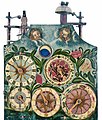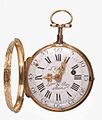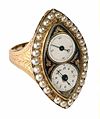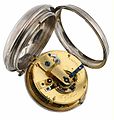|
German Clock Museum
The German Clock Museum[2] (German: Deutsches Uhrenmuseum) is situated near the centre of the Black Forest town of Furtwangen im Schwarzwald (Germany), a historical centre of clockmaking. It features permanent and temporary exhibits on the history of timekeeping.[3] The museum is part of the local technical college (Hochschule Furtwangen).[4] About the museumThe German Clock Museum is devoted to the history of timekeeping devices. A major focus is on clockmaking in the Black Forest, both as a cottage industry and on an industrial scale. The museum has an extensive collection of clocks and other artefacts relating to horology, not just those from the Black Forest, but also clocks and watches from around the world and spanning from prehistoric times to the present. The collection includes early cuckoo clocks from the 18th century as well as the prototypes of the modern Black Forest souvenir. The work of Robert Gerwig formed a primary basis of the museum. 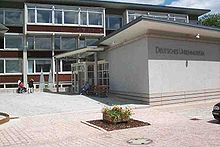 Chronology1852: Robert Gerwig, Director of the Grand Ducal Baden Clockmaking School in Furtwangen, began to collect old clocks as witnesses of traditional handicrafts. 1858: The collection is exhibited for the first time at the Black Forest Industry Exhibition in Villingen. 1874: Historical clocks together with contemporary products of the region are put on display in the newly built trade hall. 1925: The first printed collection catalogue of the Adolf Kistner Historical Clock Collection already lists over 1,000 clocks. 1959: A new building is opened on the site of the old wooden building that had fallen into decay. 1975: The state of Baden-Württemberg purchases the important clock collection from the Kienzle clock factories and transfers it to the museum. Due to the expansion of its collection to include pocket watches and Renaissance clocks, the "Historic Clock Collection" is renamed in 1978 to the "German Clock Museum". 1992: The current museum building is opened. Today, the German Clock Museum is part of Furtwangen University.[5] ExhibitsSince 2010, the museum has put on a permanent exhibition, covering an area of 1,400 square metres, of the development of clocks and the concept of timekeeping in Western countries.[6] In addition to improvements in the accuracy of timepieces, it also demonstrates the various requirements that clocks and watches met in order to satisfy the needs of the time. Thus, in addition to prize exhibits, the museum also displays objects that, despite their low value, were historically very important. This distinguishes the German Clock Museum from clock collections that display objects that were rather rare and expensive compared with those in typical everyday use. The circular tour is divided into the sections covering the following themes:
History of Clocks and Time up to IndustrialisationUntil well into the 20th century, clocks were based on the (apparent) course of the sun and the stars in the sky. This connexion is clearly built into the works of the priest-mechanics of the 18th century with their clockwork models of the cosmos. In addition to the astronomic calendar clock of Benedictine father and later mathematics professor, Thaddäus Rinderle, of 1787 (Inv. 16-0033), the Copernican Planetarium (Inv. 43-0002, 1774) and a globe clock (Globenuhr, Inv. 43-0001, before 1788) by Philipp Matthäus Hahn are part of the collection.
Wooden clocks from the Black ForestIn the 18th and 19th centuries, the Black Forest supplied the world with low cost clocks. In many small clockmaking workshops, clocks with wooden movements were made which, thanks to the cheap raw material, the use of special tools and machines and specialised craftsmen, were inexpensive and faced no real competition. A wooden clock face with a white background and colourfully painted motif decorated the Black Forest clocks during the whole of the 19th century. With a colourless, protective varnish the clock faces were resistant to moisture and dirt. From the second half of the 18th century, the varnished plate clock (Lackschilduhr) dominated the European market. Later, it found its way overseas and to the Far East. The design of the clock plate varied depending on the country being exported to. Black Forest traders, the clock carriers (Uhrenträger), sold the clocks locally.
Clock industry in the Black ForestIn the second half of the 19th century, clock factories displaced the traditional manufacture of clockmaking in the home. Initially relatively small firms emerged that specialised in the production of short runs of qualitatively high value clocks based on the traditional prototype. Over time the factories that became successful were those, especially in the Württemberg (eastern) half of the Black Forest and neighbouring Baar region, that embraced new types of clock, like alarm clocks, that were suited to industrial processes. In most households there was a clock suited to each room, from the alarm clock to the kitchen clock to the sideboard or wall clock.
Pocket watchesIn the 16th and 17th centuries the sometimes voluminous neck clocks (Halsuhren) were more of an expensive piece of jewellery than an accurate timepiece. Not until the time around 1800 were the first pocket watches available for the landed gentry and for science, but at best they displayed minutes. As a result of industrial manufacturing in the second half of the 19th century, however, the pocket watch became an everyday item.
 HighlightsAmong the highlights of its permanent exhibits are:
Tourism and visitors Around one third of visitors book a personal guided tour during which clocks and musical instruments are set in motion. Especially during the holidays children may build and decorate a clock in the "clock workshop". For school classes, the museum offers themed workshops in modules, some of which are designed to match the education syllabus. The collection has 8,000 items and about 1,300 clocks are permanently displayed. As well as clocks, the collection includes a company documents archive and a specialist library of German-language literature. In 2006, the museum was one of 365 places selected to represent Germany in the federal chancellor's competition Land of Ideas. In 2008, the museum was awarded the distinction of being an "anchor point on the European Route of Industrial Heritage". At the same time, the museum became a milestone on the German Clock Road that links places in the region associated with clockmaking. In 2010, the museum had 60,000 visitors. Similar museums
See also
Notes and references
External linksWikimedia Commons has media related to Deutsches Uhrenmuseum.
|
||||||||||||||||








